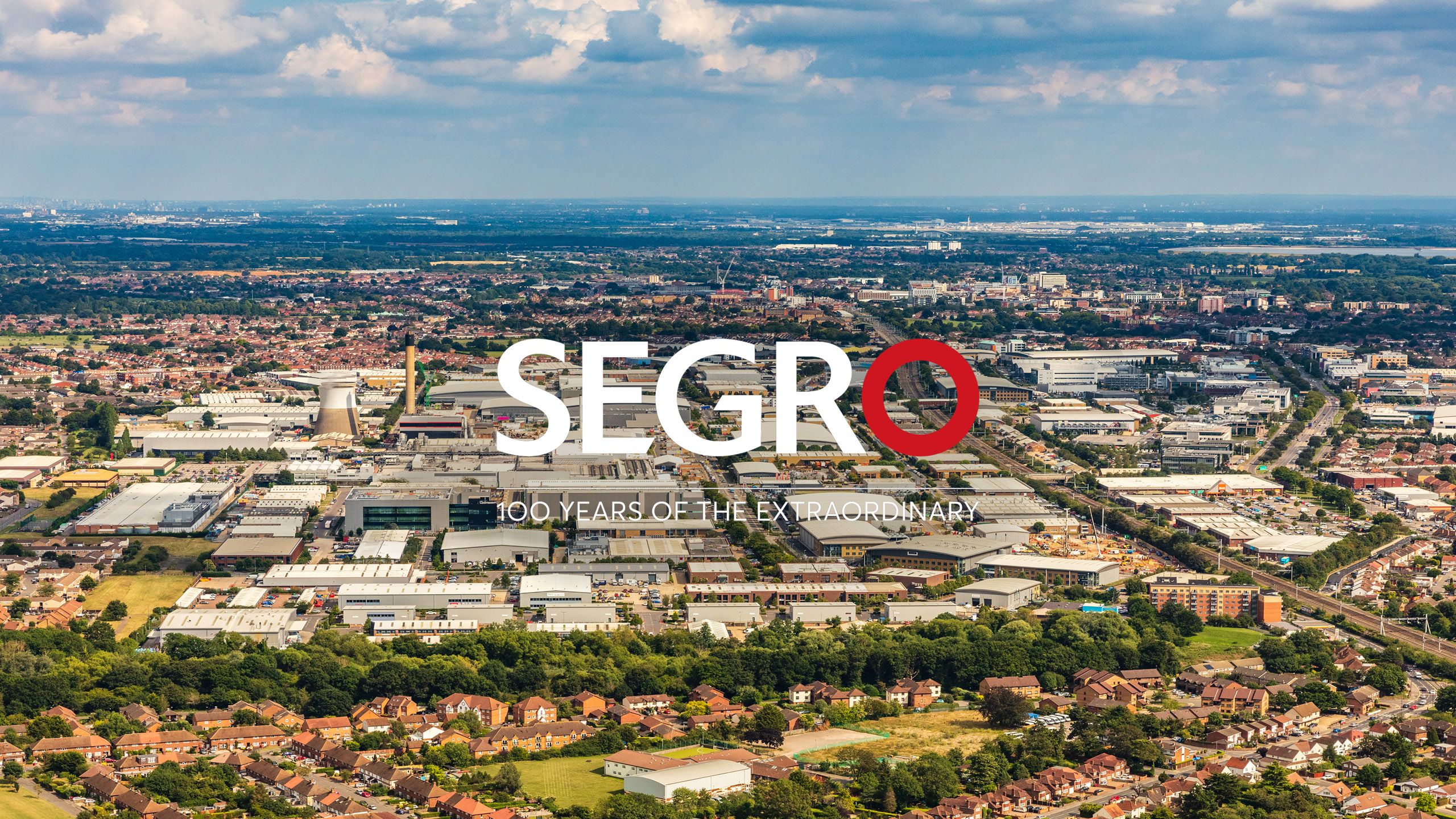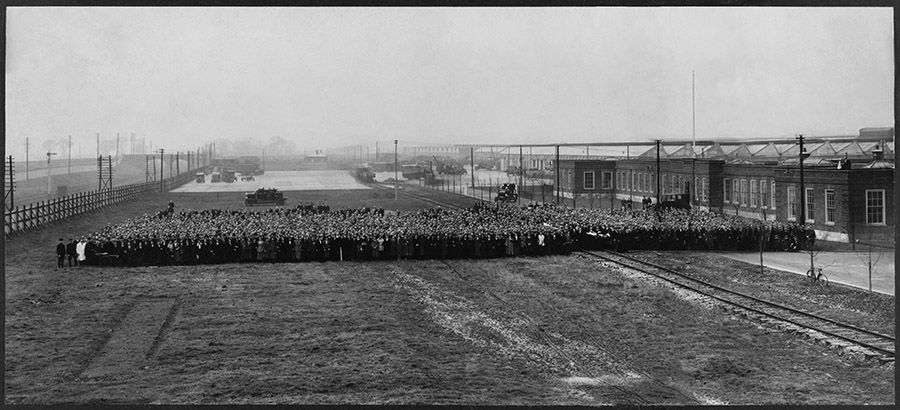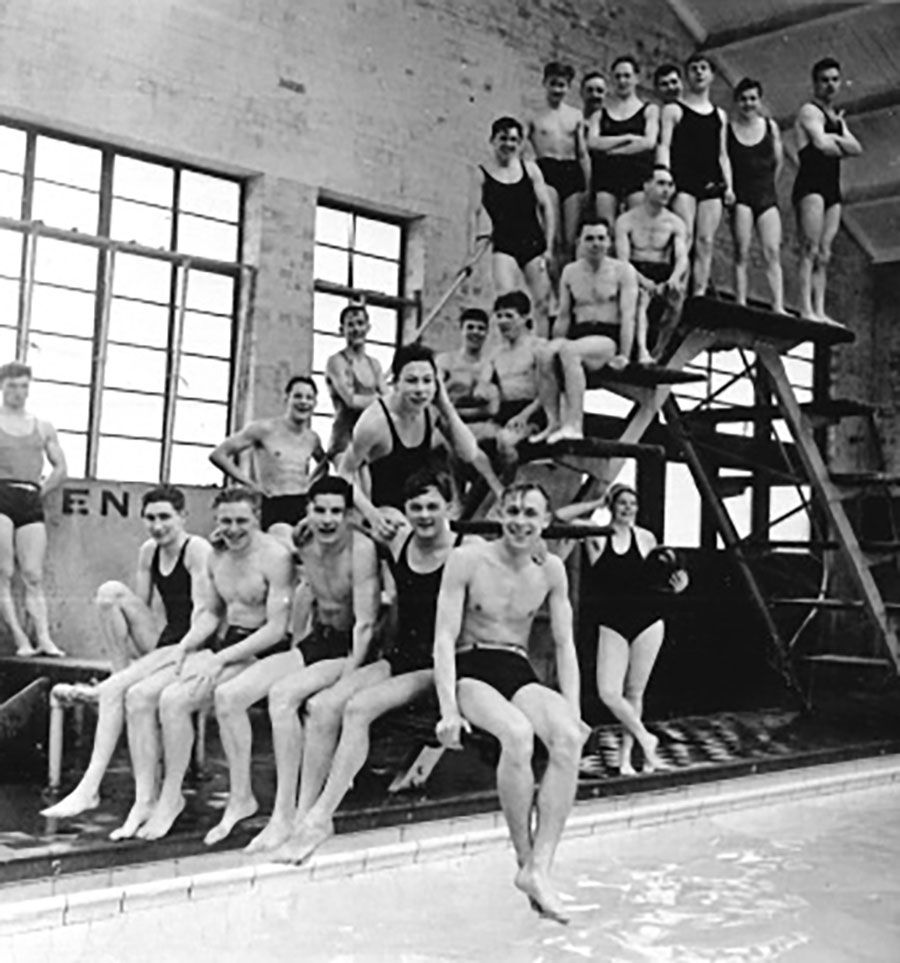
From the 1920s through to present day.
Our story so far...

During the First World War, the British Government established a military repair depot in Slough.

After the war, in 1920, Lord Percival Perry, Redmond McGrath and Noel Mobbs founded The Slough Trading Company Ltd and purchased the depot, buildings and vehicles for £7 million. They rehired the original War Department staff, adapting the military vehicles for civilian use. They also reduced the staff working hours without any reduction in earnings.

The military vehicles were quickly recycled and sold off, thereby making some of the original workshops surplus to requirement, which were then made available for rent and were successfully let to a variety of customers. In doing so, we became a property company. Thus was born the modern industrial estate at Slough, a pioneering concept that has since been copied all over the world.

This is the first recorded image of the workers at Slough, taken in 1920. Using the latest technology, let’s now imagine what it was like to have been there 100 years ago...



Enabling our customers' success

The next step was to set about creating the infrastructure needed for further development – including the estates own Police force and Fire service.


We also supported the British Government in setting up one of the first worker training centres, a concept that continues to this day with Slough Aspire.
In 1926 the company name was changed to Slough Estates Ltd and we focused on producing world leading spaces for our customers.

This is St Martins Preserves, one of our first customers. The factory specialised in jam which was made in Slough for export throughout Europe. But how did it get transported back in the 1920s?
In an early innovation, the estate was connected to the Great Western Railway with its own station allowing the estate’s workers to commute by train and freight wagons were loaded from within the buildings enabling the transportation of supplies in and goods out by rail.

This theme of providing good transport links continues today; be it at SEGRO Logistics Park East Midlands Gateway, adjacent to the M1 motorway and East Midlands Airport which has its own rail freight terminal or Air 2 in Paris that takes advantage of the multi-modal facilities of road, rail and river.

Care in the workplace

We have always considered workers’ welfare to be of great importance and in 1936, we established the Slough Community Centre which featured over 150 bodies and societies offering a very broad range of activities for people on the estate.

In 1947 we launched our own Industrial Health service, a year before the NHS was formed. This featured state of the art mobile diagnostic equipment, such as X-ray machines that could go to the factories to treat people immediately when the need arose. The welfare of our employees and those of our customers was and is still is of real importance to us.

In 1950 we launched our new London headquarters, Slough Estates House that became a centre for our customers who could use the facilities, including conference and board rooms, and showcase their products to buyers from all over the world.

Slough Estates House
A gallery of images from the 1950s

Expansion through the 20th century

As we moved into the second half of the 20th century, we continued to grow both in the UK and globally, purchasing land in Australia and Canada in the 1950s.
Entering the 1960s, with a pre-tax profit of over £1m, we started to develop the land we had acquired in Sydney and Melbourne.

Back in the UK, growth continued a-pace through both development and the acquisition of sites and companies.
As our business evolved, a more diverse range of sectors joined us across our portfolio. Companies such as AP Films, who made classic TV programmes such as Thunderbirds,


and the global computer giant Hewlett Packard amongst many others.
In fact the technology sector has long been a significant customer base for us and today the Slough Trading Estate is home to the second largest portfolio of Data Centres in the world.
We welcomed in the 1970s by celebrating our 50th anniversary with a massive increase in both the UK and international expansion with... The USA and markets where we have subsequently grown significantly over the last decades including France in 1972 and Germany in 1974.

Today France and Germany are two of our most important countries with portfolios valued at £1.3billion and £1.5billion respectively.

The 1980s saw a decade of continued growth and profitability which continued through the 90s to the point that by 1994, we became the largest Industrial property developer in the UK and Europe.

Securing our place
in the new Millennium

We entered the new Millennium with a continued focus on modernisation and growth and acquired Brixton plc which enhanced our portfolio across the UK, while further acquisitions in Europe gave us assets in the Netherlands, Hungary and the Czech Republic.
In 2005, we started operating in Poland, now one of our key geographies with a portfolio valued at over £900 million.

In 2007 we changed the company name to SEGRO plc and became a UK Real Estate Investment Trust, with the last ten years proving our most successful decade to date.
2011 saw us announce a strategic plan to reposition SEGRO as a leading REIT and the best owner manager of industrial property, selling our retail and office assets. In 2013, SELP, the SEGRO European Logistics Partnership, was created, seeded with property valued at approximately £1 billion. It is now worth over £3.9 billion.
We continued to expand in Europe increasing our holdings in Italy by acquiring Vailog in 2015 while also re-established our presence in the Spanish market.
In the UK, we acquired Roxhill in 2018 as we continued to deliver on our strategy to grow our big box warehouse position in the UK. And in 2019 we became the biggest property company in the UK by market capitalization with 7.8 million square metres of space valued at £11.7 billion.


Innovation today and in the future

As we move further into the digital era, we have a modern, well located portfolio of big box and urban warehouses, data centres and other properties that encompass a wide range of uses serving a diversified customer base. Our purpose is to ‘create the space to enable extraordinary things to happen’ and we are committed to achieving this in the most sustainable way possible and by using the latest technology.

We are creating spaces with ecologically friendly green walls, sensor technology, full photo voltaic roofs as well as solar walls, expanding the use of battery technology, biodiversity initiatives and incorporating sensors that provide an incredible amount of data for both SEGRO and our customers.

We believe the concept of Corporate Social Responsibility can be explained quite simply; it is doing the right thing. The right thing for the environment, for the communities in which we operate and the right thing for our customers, our employees and stakeholders.

Nobody knows exactly what the future will bring but we have always been forward thinking. Today we are just as mindful that future disruptors and technologies could affect us all, progressing from theoretical ideas to real life modern workplace solutions at a rapid pace.
In order to enable these technologies, you need to be flexible and quickly adapt to a changing world, therefore we are constantly horizon scanning to ensure we really understand what our customers need, right now, in the near future and far ahead.

